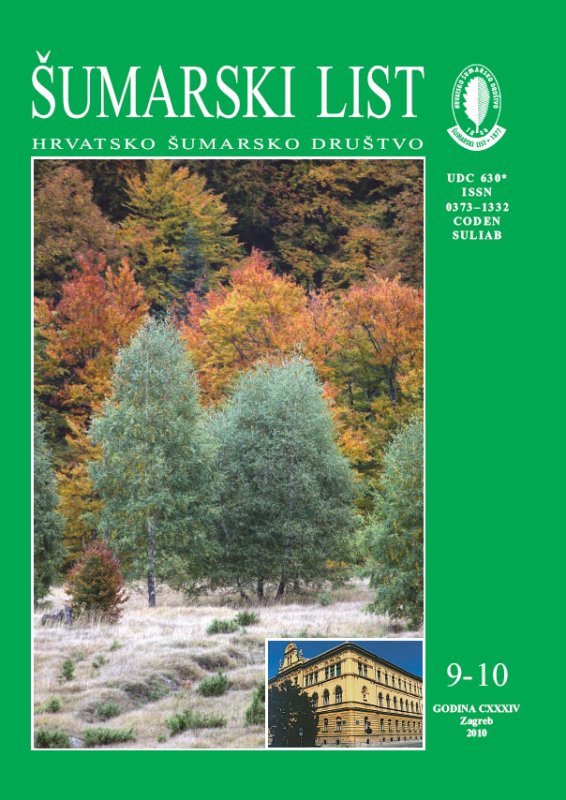
broj: 9-10/2010
pdf (7,71 MB) |
|
||||||||||||||
| RIJEČ GLAVNOGA UREDNIKA | ||
| Branimir Prpić | ||
| THE NEW FOREST LAW pdf HR EN | 445 | |
| As we all know, preparations are under way to introduce the new Forest Law. The new Law will contain an important regulation which defines the use of forests and the actual size of forest and forestland area. According to Article 1, paragraph 1 of the valid Forest Law, forests and forestland are goods of interest to the Republic of Croatia and enjoy its particular protection. The specific nature of this natural wealth and its functions of general benefit, according to Article 3, paragraph 1, require special management methods. In paragraph 3 of the same article, non-market forest functions are listed in 15 points (regrettably, many forget that, in addition to classical forest management, the first and foremost task of the forestry profession is to ensure undisturbed provision of non-material forest functions). We expect that no changes will be made in the new law in this respect. The concept of forests and forestland is discussed in Article 4 of the Law, which also states that the Ministry of Agriculture and Forestry is competent for all arbitration cases. However, we must wonder whether forests and forestland have always been treated in accordance with the above articles. The Croatian Forestry Association has on several occasions discussed the issue and expressed dissatisfaction with some solutions in legal and by-legal acts. Petar Jurjević, MSc, President of the CFA, reported on this issue at the 114thelectoral assembly of the CFA for a four-year period. He was particularly dissatisfied with the regulation of the Forest Law which states that “to establish perennial cultures next to unproductive forest land it is allowed to use maquis, while we should know and constantly stress that maquis is a forest”. He also mentioned the following interesting fact: in those areas in which the demand for forestland is the highest there are hundreds of thousands of hectares of uncultivated, abandoned agricultural land. Incidentally, this is where over 50% of forest fires occur. He particularly criticized the fact that the current compensation for forests and forestland is only symbolic and unrealistic, since its amount in no way suffices to establish new forests in the same area. Needles to say, the amount of compensation is widely disproportionate to the value of goods of interest to the Republic of Croatia, as stated in Article 1 of the Forest Law. As mentioned in the Report, we are aware of the fact that “in the past period, due to diverse circumstances, state forests and forestland area also incorporated former abandoned agricultural land which is currently covered with forests resulting from succession.” It is the inaccurate definition of forests and forestland that causes numerous conflicts and discord between the forestry sector and some other sectors, in the first place agriculture. We expect that the new categorization regulated by the future Forest Law, as well as the Law on Agricultural Lend will accurately define forests and forestland and that it will treat them in accordance with Article 1 of the valid Forest Law. We hope that the new Law will prohibit cases in which cultures, olive groves and vineyards are established on strictly forest soils simply because the owner is defined, or in which wild game, an indelible part of the forest fauna, is driven away from forests to make way for domestic cattle and their grazing and browsing needs (examples from Croatian islands). Wealso expect that all areas which are currently listed as agricultural areas but are unsuitable for agriculture (about 800.00 ha), will be used for forest cultures and plantations with pioneer and fast-growing tree species, which can be used for bio energy and other purposes. Professor Emeritus Branimir Prpić, Ph.D. | ||
| IZVORNI ZNANSTVENI ČLANCI | ||
| Pandža,M., V.Krpina | UDK 630* 187 + 188 (001) | |
| Forest Vegetation of the Island of Vrgada and its Islets (Dalmatia, Croatia) pdf HR EN | 447 | |
| Pejnović,D., K.Krapinec, M.Slamar | UDK 630* 156 (001) | |
| Hunters in Croatia as a Socio-Geographic Group and their Socio-Demographic Characteristics pdf HR EN | 461 | |
| Šerić Jelaska, L., A. Ješovnik, S. D. Jelaska, A. Pirnat, M. Kučinić, P. Durbešić | UDK 630* 114.6 + 411 (001) | |
| Variations of Carabid Beetle and Ant Assemblages, and their Morpho-ecological Traits within Natural Temperate Forests in Medvednica Nature Park pdf HR EN | 475 | |
| Čas, Miran | UDK 630* 156 (001) | |
| Disturbances and Predation on Capercaillie at Leks in Alps and Dinaric Mountains pdf HR EN | 487 | |
| PRETHODNO PRIOPĆENJE | ||
| Matošević, D., M. Pernek, B. Hrašovec | UDK 630* 453 | |
| First Record of Oriental Chestnut GallWasp (Dryocosmus kuriphilus) in Croatia pdf HR EN | 497 | |
| PREGLEDNI ČLANCI | ||
| Tomićević, J., M. A. Shannon, D. Vuletić | UDK 630* 903 + 907.1 | |
| Developing Local Capacity for Participatory Management of Protected Areas: The Case of Tara National Park pdf HR EN | 503 | |


